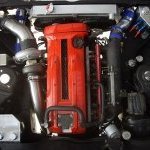Gtr Bov
Announcements
-
Similar Content
-
Latest Posts
-
Well the install is officially done. Filled with fluid and bled it today, but didn't get a chance to take it on a test drive. I'll throw some final pics of the lines and whatnot but you can definitely install a DMAX rack in an R33 with pretty minor mods. I think the only other thing I had to do that isn't documented here is grind a bit of the larger banjo fitting to get it to clear since the banjos are grouped much tighter on the DMAX rack. Also the dust boots from a R33 do not fit either fyi, so if you end up doing this install for whatever reason you'll need to grab those too. One caveat with buying the S15 dust boots however is that the clamps are too small to fit on the R33 inner tie rod since they're much thicker so keep the old clamps around. The boots also twist a bit when adjusting toe but it's not a big deal. No issues or leaks so far, steering feels good and it looks like there's a bit more lock now than I had before. Getting an alignment on Saturday so I'll see how it feels then but seems like it'll be good to go
-
I don't get in here much anymore but I can help you with this. The hole is a vent (air relief) for the brake proportioning valve, which is built into the master cylinder. The bad news is that if brake fluid is leaking from that hole then it's getting past the proportioning valve seals. The really bad news is that no spare parts are available for the proportioning valve either from Nissan or after market. It's a bit of a PITA getting the proportioning valve out of the master cylinder body anyway but, fortunately, leaks from that area are rare in my experience. BTW, if those are copper (as such) brake lines you should get rid of them. Bundy (steel) tube is a far better choice (and legal in Australia - if that's where you are).
-
EMU Classic. For what I need it to do I see no reason to upgrade. Link and Haltech would both cost an extra chunk of money for a lot of unutilized features






Recommended Posts
Create an account or sign in to comment
You need to be a member in order to leave a comment
Create an account
Sign up for a new account in our community. It's easy!
Register a new accountSign in
Already have an account? Sign in here.
Sign In Now